Unit 13: Standard Business Style
Learning Objectives
 After studying this unit, you will be able to
After studying this unit, you will be able to
-
-
- edit your writing using elements of business writing style
- apply the 6 C’s of business writing
- ensure your writing has the correct tone
-
Introduction
Among the most important skills in communication is to adapt your writing style according to the audience to meet their needs as well as your own. Different audiences: a co-worker, the manager, the customer, required different communication styles. In each case, these audiences have certain expectations about the style of communication, and writers must meet those expectations to be respected and maintain good relations. This section reviews writing style choices and focuses especially on the six major characteristics of good writing common to both formal and casual writing. Take a look at the following video to see if you can pick up in the appropriate and inappropriate use of language.
Source: CBC Comedy (2017)
The Formality Spectrum
Unit 5 looked at the general choice between a formal and informal style of writing based on audience profile considerations. There, we saw how certain situations call for formal writing and others for a more relaxed style and saw that these styles involve word choices along a spectrum of synonyms from “slangy” to casual to fancy. Here we will review those considerations in the context of the writing process.
Formal Style in Writing
Because a formal style of writing shows respect for the reader, use standard business English especially if your goal is to create goodwill with your audience, such as anyone outside your organization, higher than you within your organization, and those on or around your level with whom you have never communicated with before. These audiences include managers, customers, clients, B2B suppliers and vendors, regulators, and other interested stakeholders such as government agencies. A cover letter, for instance, will be read by a potential manager probably unfamiliar to you, so it is a very real test of your ability to write formally—a test that is crucial to your career success. Many common professional document types also require formality such as other letters, memos, reports, proposals, agreements, and contracts. In such cases, you are expected to follow grammatical rules more strictly and make slightly elevated word choices, but not so elevated that you force your reader to look up rarely used words (they will not; they will just make up their mind about you being pretentious and a slight pain to deal with).
Writing in such a style requires effort because your grammar must be tighter and the vocabulary advanced. Sometimes a more elevated word choice—one with more syllables than perhaps the word that comes to mind—will elude you, requiring you to use a thesaurus (such as that built into MS Word in the Proofing section under the Review menu tab, or the Synonyms option in the drop-down menu that appears when you highlight and right-click a word). At the drafting stage you should, in the interests of speed-writing to get your ideas down nearly as fast as they come, go with the word that comes to mind and leave the synonym-finding efforts for the editing stage. Strictly maintaining a formal style in all situations would also be your downfall, however, because flexibility is also expected depending on the situation.
Conversational Style in Writing
Your ability to gear-down to a more casual/conversational style is necessary for any situation when communicating with familiar people generally on your level and when a personable, conversational tone is appreciated, such as when writing to someone with basic reading skills (e.g., an EAL learner, as we saw in unit 5). In a routine email to a colleague, for instance, you would use the informal vocabulary exemplified in the semi-formal/common column of Table 5.1, including conversational expressions such as “a lot” instead of the more formal “plenty.” You would also use contractions such as it’s for it is or it has, would’ve for would have, and you’re for you are. While not a sign of disrespect, the more relaxed approach says to the reader “Hey, we’re all friends here, so let’s not try so hard to impress each other.” When an upper-level manager wants to be liked rather than feared, they’ll permit a more conversational style of communication in their employees’ interactions with them, assuming that doing so achieves collegiality rather than disrespect.
Incidentally, this textbook mostly sticks to a more conversational style because it’s easy to follow for a readership that includes international EAL learners. Instead of using the slightly fancy, three-syllable word “comprehend” in the middle of the previous sentence, for instance, “follow” gets the point across with a familiar, two-syllable word. Likewise, “casual” is used to describe this type of writing because it’s a six-letter, three-syllable word that’s more accessible to a general audience than the ten-letter, four-syllable synonym “colloquial.” These word choices make for small savings in character- and word-counts in each individual case, but, tallied up over the course of the whole book, make a big difference in size, tone, and general readability, while remaining appropriate in many business contexts. Drafting in such a style is easy because it generally follows the diction and rhythms that come naturally in common conversation.

Slang Style in Writing
As the furthest extreme on the formality spectrum, slang and other informal means of communication such as emojis are generally unacceptable in business contexts. Since slang is common in teen texting and social media, it appears immature, frivolous, out of place, confusing, and possibly even offensive in serious adult professional situations. Say someone emailed a car cleaning company with questions about their detailing service and received a reply that looks like it was texted out by a 14-year-old such as:
Fo sho i set u up real good, well get yr car cleen smoove top 2 bottom – inside + out – be real lit when were done widdit, cost a buck fiddy for da hole d-lux package, so u down widdit erwat
The inquiring customer would have serious concerns about the quality and educational level of the personnel staffing the company, and thus about the quality of work they’d do. The customer will probably look for another company with a more business-appropriate style that suggests greater attention to detail and awareness of professional communication standards. A more appropriate response is likely to assure the customer that their car is in good hands:
Absolutely, we can do that for you. Our White Glove service thoroughly vacuums and wet-vacs all upholstery, plus scrubs all hard surfaces with pro-grade cleaners, then does a thorough wash and wax outside. Your autobody will be like a mirror when you pick it up. Please let us know if you are interested in our $150 White Glove service.
In terms of the writing process, professionals should generally avoid slang style in almost all business situations. If slang is your style, it’s in your best interests to bring your writing habits up to the casual/conversational level with constant practice. Perhaps slang-heavy style would be appropriate when texting a trusted colleague or marketing to teens, but generally, slang should be avoided because it tends to deviate from the typical characteristics of good business writing.

Emojis in Professional Writing
Though emojis’ typical appearance in social media and texting places them at the informal end of the formality spectrum, their advantages in certain situations require special consideration along with some clarity about their current place in professional communication. Besides being easy to access on mobile device keyboards and favoured in social media communication, especially among millennials, emojis are useful for helping clarify the emotional state of the message sender in a way that plain text can’t. They offer a visual cue in lieu of in-person nonverbals. A simple “thumbs up” emoji even works well as an “Okay, got it” reply in lieu of any words at all, so they can help save time for the busy professional. Interestingly, 2,500 years after Egyptian hieroglyphics fell out of use, pictographs are making a comeback! Emojis also go partway toward providing something of a universal language that allows people who speak different languages to communicate in a way that wouldn’t have been possible otherwise.
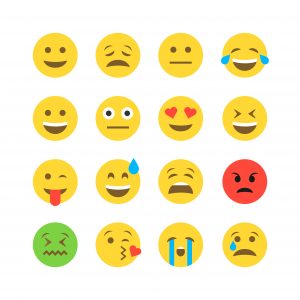 However, the lack of precision in emojis can also cause confusion as they may be interpreted differently if the social and cultural context of the receiver differs enough from that of the sender (Pringle, 2018), not to mention differences in their emotional states. This means that emojis aren’t as universal as some claim they are, especially when used by correspondents who speak different languages (Caramela, 2018). Even between those who speak the same language, a smiley-face emoji added to a lightly insulting text message might be intended as a light-hearted jab at the receiver by the sender but might be read as a deeply cutting passive-aggressive dig by the receiver. The same text message said in person, however, comes with a multitude of nonverbal cues (facial expressions, eye movements, body movements, timing, voice intonation, volume, speed, etc.) that help the listener determine the exact intentions of the speaker—meanings that can’t possibly be covered by a little 2D cartoon character.
However, the lack of precision in emojis can also cause confusion as they may be interpreted differently if the social and cultural context of the receiver differs enough from that of the sender (Pringle, 2018), not to mention differences in their emotional states. This means that emojis aren’t as universal as some claim they are, especially when used by correspondents who speak different languages (Caramela, 2018). Even between those who speak the same language, a smiley-face emoji added to a lightly insulting text message might be intended as a light-hearted jab at the receiver by the sender but might be read as a deeply cutting passive-aggressive dig by the receiver. The same text message said in person, however, comes with a multitude of nonverbal cues (facial expressions, eye movements, body movements, timing, voice intonation, volume, speed, etc.) that help the listener determine the exact intentions of the speaker—meanings that can’t possibly be covered by a little 2D cartoon character.
Be careful with emojis also in any situation involving buying or selling, since commercial messages can end up in court if meanings, intentions, and actions part ways. In one case, emojis were used in a text message signaling intent to rent an apartment by someone who reneged and was judged to be nonetheless on the hook for the $3,000 commitment (Pringle, 2017). As with any new means of communication, some caution and good judgment, as well as attention to notable uses and abuses that show up in the news or company policy directives, can help you avoid making potentially disastrous mistakes.
Though emojis may be meaningfully and understandably added to text/instant messages or even emails between familiar colleagues who have developed a light-hearted rapport featuring their use, there are several situations where they should be avoided at all cost because of their juvenile or frivolous social media reputation. It’s a good idea to avoid using emojis in business contexts when communicating with:
- Customers or clients
- Managers who don’t use emojis themselves
- Colleagues you don’t know very well
- Anyone outside your organization
However, in any of the above cases, it would probably be safe to mirror the use of emojis after your correspondent gives you the greenlight by using them first (Caramela, 2018). Yes, emojis lighten the mood and help with bonding among workplace colleagues. If used excessively as part of a larger breakdown of decorum, as mocked in the accompanying Baroness von Sketch Show short video above (CBC Comedy, 2017), they suggest a troubling lack of professionalism. Managers especially should refrain from emoji use to set an example of impeccable decorum in communications to the employees they supervise.
Knowledge Check: Use the information above to answer the following questions.
The 6 Cs of Style
Whether you’re writing in a formal or casual/conversational style, all good writing is characterized by the “6 Cs” of communication:
- Clear
- Concise
- Coherent
- Correct
- Courteous
- Convincing
Six-C writing is good for business because it fulfills the author’s purpose and meets the needs of the audience by making communication understandable and impactful. Such audience-oriented writing is clearly understood by busy readers; it doesn’t confuse them with ambiguities or require them to come back with questions for clarification. It gets the point across in as few words as possible so that it doesn’t waste readers’ time with wordcount-extending filler.
Good writing flows logically by being organized according to recognizable patterns with its sub-points connected by well-marked transitions. Six-C writing avoids confusing readers with grammar, punctuation, or spelling errors, as well as avoids embarrassing its author and the company they represent, because it is flawlessly correct. It leaves the reader with a good feeling because it is polite, positive, and focuses on the reader’s needs. Six-C writing is persuasive because, with all the above going for it, it exudes confidence. The following sections explain these characteristics in greater detail with an emphasis on how to achieve Six-C writing at the drafting stage. Let’s begin with a video presentation before focusing on each of the Six-Cs.
1. Clarity
Clarity in writing means that the words on the page are like a perfectly transparent window to the author’s meaning. Business or technical writing has no time for anything that requires the reader to interpret the author’s meaning or ask for clarification. To the busy reader scanning quickly, bad writing opens the door for wrong guesses that, if acted upon, result in mistakes that must be corrected later; the later the miscommunication is discovered and the further the mistakes spread, the greater the damage control required. Vague writing draws out the communication exchange unnecessarily with back-and-forth requests for clarification and details that should have been clear the first time. Either way, a lack of clarity in writing costs businesses by hindering personal and organizational productivity. Every operation stands to gain if its personnel’s writing is clear in the first place.
Confusion and misunderstanding based on unclear expressions and language can be avoided if hard facts, precise values, and specific pronouns, and concrete descriptions are used. Figure 13.3 demonstrates the use of these strategies to achieve clarity in writing.
Knowledge Check
2. Conciseness
The principle that business writing is economical means to communicate ideas in as few words as possible without compromising clarity. Bad writing makes simple things sound complicated. This is a rookie mistake among some students new to college or employees new to the workforce. Writing long and complex sentences is likely to frustrate audiences.
Readers expect to receive information that gets directly to the point directly. Employees, customers, and other stakeholders want to receive concise messages. Concise writing presents a better understanding of information to readers. Figure 13.4 illustrates the benefits of this principle for consumers.
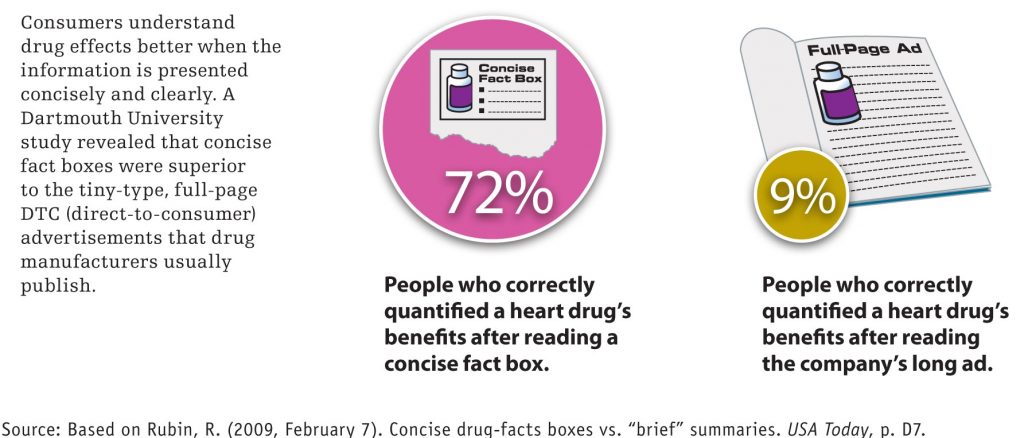
When In the writing process, time spent upfront eliminating wordy phrases will benefit the reader and create a feeling of goodwill towards the sender. Figure 13.4 presents several strategies to achieve concise writing.
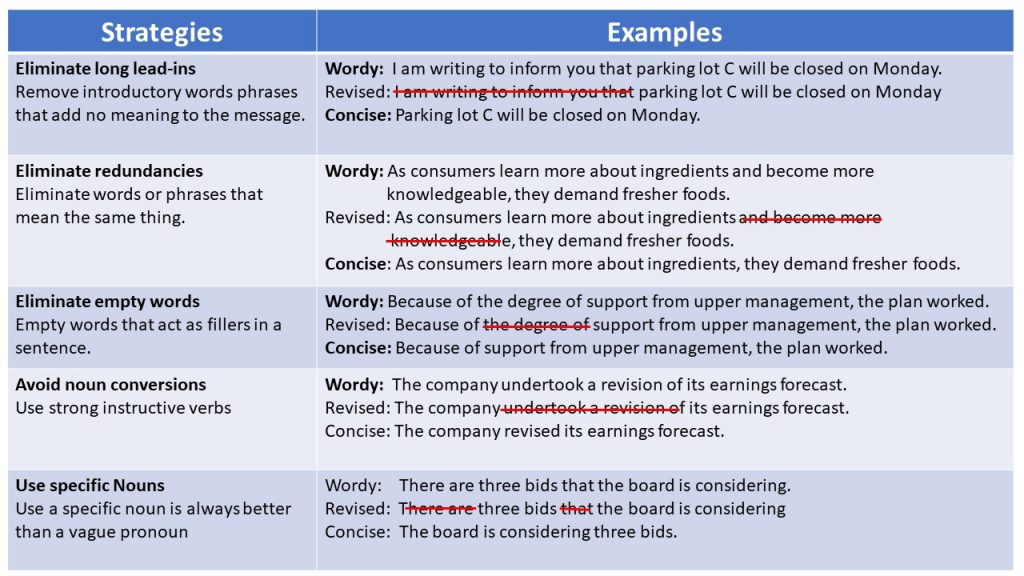
Writing wordy messages in the drafting stage is acceptable, but such messages must be edited later. When editing, a writer must understand how much information readers need. Ensuring the message is concise yet complete is the objective of a good writer.
Knowledge Check
3. Coherence and Completeness
Coherence means that your writing flows logically and makes sense because it says everything it needs to say to meet your audience’s needs. The organizational patterns discussed in unit 11, outlining structures in unit 12, and paragraph organization all help to achieve a sense of coherence. The pronouns and transitions you use especially help to connect the distinct points that make up your bare-bones outline structure as you flesh them out into meaningful sentences and paragraphs.
4. Correctness
Correct spelling, grammar, mechanics, etc. should not be a concern at the drafting stage of the writing process, though they certainly must be at the end of the editing stage. Speed-writing to get ideas down requires being comfortable with the writing errors that inevitably pockmark your draft sentences. The perfectionists among us will find ignoring those errors difficult, but resisting the temptation to bog yourself down by on-the-go proof-editing will pay off at the revision stage when some of those awfully written sentences get chopped in the end anyway. Much of the careful editing during the drafting stage will have been a waste of time.
5. Courteous language
No matter what type of document or the expected audience reaction, courteous writing communicates respect for the reader and is fundamental to reader-friendly messages. Whether you’re simply sharing information, making a sales pitch, explaining a procedure, or doing damage control, using polite language helps ensure your reader will be receptive to the information. Saying please never gets old when asking someone to do something for you, nor does saying thanks when they’ve done so—but there’s more to it than that.
Much of courtesy in writing involves taking care to use words that encourage cooperation and avoid negative, critical, pushy, and demanding words and phrases. If you’re processing a contract and the client forgot to sign and date it, for instance, the first thought that occurs to you when emailing to inform them of the error may go something like the following:
You forgot to sign and date our contract, so you’ve got to do that and send it to me a.s.a.p. because I can’t process it till I receive it signed.
Now, if you were the client reading this slightly angry-sounding, accusatory order, you would likely feel a little embarrassed and maybe even a little upset by the edgy, pushy tone coming through in negative words like forgot, do that, a.s.a.p., and can’t. That feeling wouldn’t sit well with you, and you will begin to build an aversion to that person and the organization they represent. Now imagine you read instead a message that says, with reference to the very same situation, the following:
For your contract to be processed and services initiated, please sign, date, and return it as soon as possible.
You would probably feel much better about coming through with the signed contract in short order. You may think that this is a small, almost insignificant shift in meaning, but the difference in psychological impact can be quite substantial, even if it operates subconsciously. Courteous writing is constructive communication that provides instructions on how to move forward. Figure 13.6 presents a few strategies to ensure your writing is courteous.
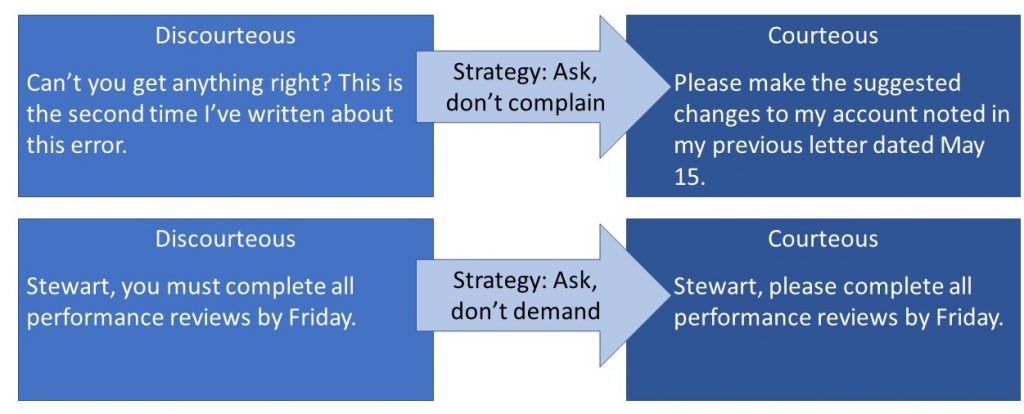
6. Convincing and Confident
Confident writing is highly convincing to readers. Writing that uses decisive language and avoids wishy-washy language like: almost, approximately, basically, might, probably, somewhat, seems and many others, will encourage your audience to accept your decision and opinions rather than question them. Being overconfident can also have consequences. Overconfidence can affect the writer’s credibility and turn readers off. To ensure your writing strikes the appropriate balance apply the following strategies.
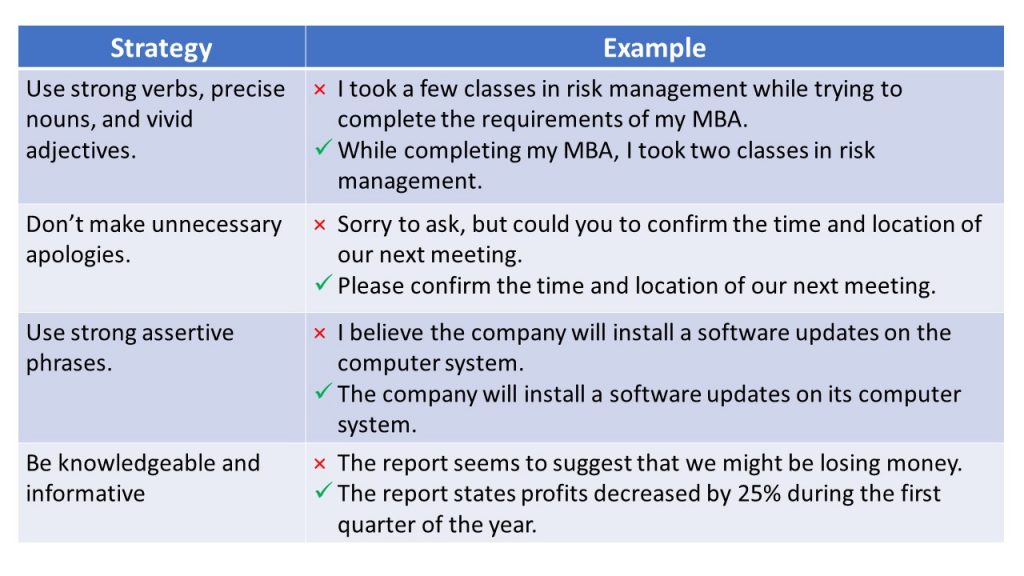
While some of the strategies in Figure 13.6 seem subtle, the overall effect is clear, authoritative, and direct writing. These qualities increase the confidence the receiver has in your message.
Knowledge Check
Key Takeaways
 Drafting involves writing consistently in a formal, casual/conversational, or informal style characterized by the “Six Cs”: clarity, conciseness, coherence, correctness, courtesy, and conviction.
Drafting involves writing consistently in a formal, casual/conversational, or informal style characterized by the “Six Cs”: clarity, conciseness, coherence, correctness, courtesy, and conviction.
Exercises
 1. Assemble a Six-Cs scoring rubric for assessing professional writing using the descriptions throughout this unit. In the highest-achievement column, list in point-form the attributes of each characteristic. In the columns describing lesser and lesser levels of achievement, identify how those expectations can fall apart. For help with the rubric form, you may wish to use Rubistar’s writing rubric template.
1. Assemble a Six-Cs scoring rubric for assessing professional writing using the descriptions throughout this unit. In the highest-achievement column, list in point-form the attributes of each characteristic. In the columns describing lesser and lesser levels of achievement, identify how those expectations can fall apart. For help with the rubric form, you may wish to use Rubistar’s writing rubric template.
2. Find examples of past emails or other documents you’ve written that make you cringe, perhaps even high school essays or reports. Identify instances where they are unclear, unnecessarily long-winded, incoherent (lacking both a clear organizational pattern and transitions that drive the argument along), rife with writing errors, rude, and/or unconvincing. Assess and score those specimens using your Six-Cs rubric from Exercise 1 above. Begin to think of how you would improve them.
3. Find a professionally written document, perhaps from a case study in another class. Assess it using the same Six-Cs scoring rubric.
4. Speed-write a written assignment that you’ve been recently assigned in one of the other courses in your program. If you’re not fast at typing (or even if you are and want to try something new), you may start by recording your message into your smartphone’s or computer’s voice recorder app or program and then transcribe it. Ensure that your style hits five of the six style Cs (clarity, conciseness, coherence, courtesy, and conviction) as you write and most definitely do not correct as you go.
References
Bovee, C.L., Thill, J. V., & Scribner J. A. (2016) Business communication essentials (4th ed.). Don Mills, ON: Pearson Canada Inc..
Caramela, S. (2018, February 5). Put a smiley on it: Should you use emojis in business communication? Business.com. Retrieved from https://www.business.com/articles/put-an-emoji-on-it-should-you-use-emojis-in-business-communication/
CBC Comedy. (2017, July 17). Work emails | Baroness von Sketch Show [Video file]. Retrieved from https://www.youtube.com/watch?v=XWA_j4Vy4oM
Goodman, S. (2016, November 23). And the most enchanting emoji on Instagram is… Curalate. Retrieved from https://www.curalate.com/blog/the-top-100-most-popular-instagram-emojis/
Gray, D. (2011, November 27). Carrot-and-stick management. Retrieved from https://www.flickr.com/photos/davegray/6416285269/
Guffey, M., Loewry, D., & Griffin, E. (2019). Business communication: Process and product (6th ed.). Toronto, ON: Nelson Education. Retrieved from http://www.cengage.com/cgi-wadsworth/course_products_wp.pl?fid=M20b&product_isbn_issn=9780176531393&template=NELSON
Me.me. (n.d.). Sometimes I use big words I don’t fully understand in an effort to make my self sound more photosynthesis. Retrieved from https://me.me/i/11273424
MindToolsVideos. (2018). The 7 Cs of Communication [Video file]. Retrieved from https://www.youtube.com/watch?v=sYBw9-8eCuM
Pringle, R. (2017, May 26). Using the wrong emoji can cost you—literally. CBC News. Retrieved from http://www.cbc.ca/news/opinion/emoji-lawsuit-1.4131697
Pringle, R. (2018, March 18). Emojis are everywhere and they’re changing how we communicate. CBC News. Retrieved from http://www.cbc.ca/news/technology/emojis-forever-pringle-1.4577456
Using the fewest words possible to convey a complete message.

